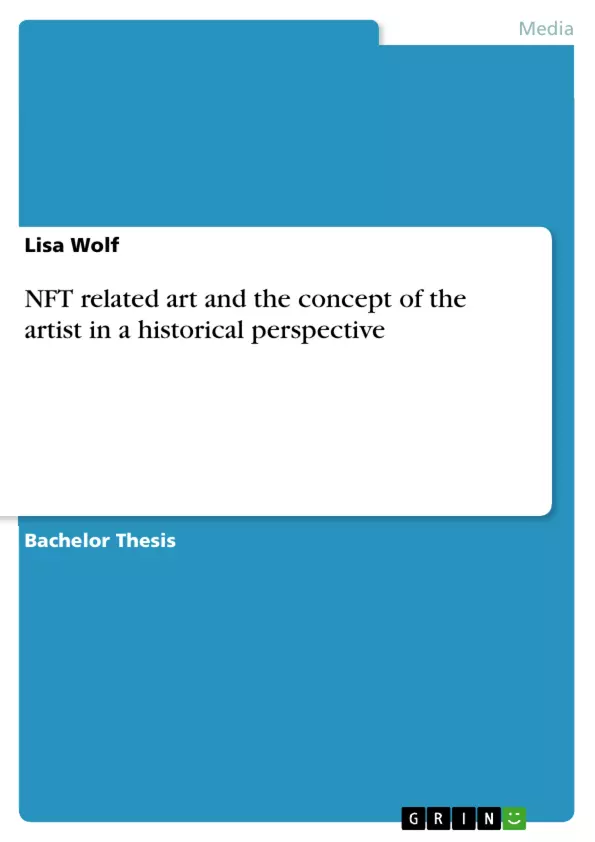Since 2021, NFTs (non-fungible token) have conquered the public and the (art)world with headlines found its way into international headlines. The sale of Everydays: The First 5000 Days has made Beeple the third most valuable living artist, behind Jeff Koons and David Hockney, displacing Gerhard Richter from the Top 3.
Kolja Reichert, art critic and curator, critically questions in one of his articles the most expensive illustrator and thereby points to a significant problem. The crypto market, originally part of online trading, had until then mainly dealt with sports trading cards, fan merchandise and products from the gaming industry. With the entry of NFTs into the traditional auction system, the collective name "NFT art" has formed, without quality standards, entry barriers, or criticism.
Based on this problem, this Bachelor thesis deals with the overarching question of what makes an NFT creator an artist and how does this concept of an artist relate to historical concepts of artists. To answer these questions, case studies of two NFTs will be conducted. While their producers have very different artistic backgrounds, both NFTs were auctioned at renowned auction houses in 2021.
Starting from the overarching question, these two examples will be used to examine whether the work can be related to historical concepts of artists, to what extent NFT technology has created a new concept of the artist, and if there are features outside of NFT technology that connect these two artworks.
Inhaltsverzeichnis (Table of Contents)
- 1. Introduction
- 2. NFT (related) art
- 2.1. Non-fungible token - NFT
- 2.2. Differentiation of NFT (related) art
- 2.3. Dread Scott and his NFT related artwork White Male For Sale
- 2.4. Beeple and his NFT related artwork Everydays: The First 5000 Days
- 3. Concept of the artist in a historical perspective
- 3.1. The influence of technical inventions on art in a historical perspective
- 3.2. Concepts of artists in a historical perspective
- 3.3. Dread Scott in the context of historical concepts of artists
- 3.4. Beeple in the context of historical concepts of artists
- 4. NFT related art in a critical view
- 4.1. The original purpose of the link between art and NFTs
- 4.2. Opportunities and limitations for artists producing NFT related art
- 4.3. Decentralization vs. Recentralization
- 4.3.1 Historic perspective on centralization in the art ecosystem
- 4.3.2 Attempts of decentralization via blockchain
- 4.4. NFT related art market and price mechanisms
- 4.4.1 Motives and drivers behind the market for NFT related art
- 4.4.2 Speculative aspect of buying NFT related art
- 4.5. Ecological impact of NFT related artworks
- 4.6. Impact of NFT related artworks on the art ecosystem
- 5. Conclusion
Zielsetzung und Themenschwerpunkte (Objectives and Key Themes)
This Bachelor's Thesis explores the connection between NFTs and the concept of the artist, analyzing whether NFT creators can be considered artists and how their approach compares to historical concepts of artistry. It aims to answer this question through case studies of two specific NFTs, considering the different artistic backgrounds of their creators and analyzing their auctioned works. The thesis investigates the role of NFT technology in shaping a new concept of the artist, examining both the opportunities and limitations presented by the technology for artists.
- The relationship between NFTs and the evolving concept of the artist
- Analysis of specific NFT artworks and their creators in the context of historical artistic concepts
- Opportunities and challenges for artists working with NFT technology
- The impact of NFTs on the art market and its mechanisms
- Critical examination of the potential for decentralization and recentralization within the art ecosystem through NFTs
Zusammenfassung der Kapitel (Chapter Summaries)
The thesis begins with an introduction to NFTs and blockchain technology, highlighting their significance in the art world and the emergence of the term "NFT art." Chapter 2 introduces the case studies of two specific NFTs, examining the artistic backgrounds of their creators and the context of their auctioned works. Chapter 3 explores the development of the concept of the artist from a historical perspective, analyzing key concepts relevant to the thesis's focus. Chapter 4 delves into a critical examination of NFTs, exploring their potential impact on the art market, the art ecosystem, and the concept of the artist, while also discussing the ecological impact of NFTs.
Schlüsselwörter (Keywords)
The key themes and topics of this thesis include non-fungible tokens (NFTs), blockchain technology, the concept of the artist, historical perspectives on art and technology, art market dynamics, decentralization vs. recentralization, and the ecological implications of NFTs.
- Citation du texte
- Lisa Wolf (Auteur), 2023, NFT related art and the concept of the artist in a historical perspective, Munich, GRIN Verlag, https://www.grin.com/document/1402410



